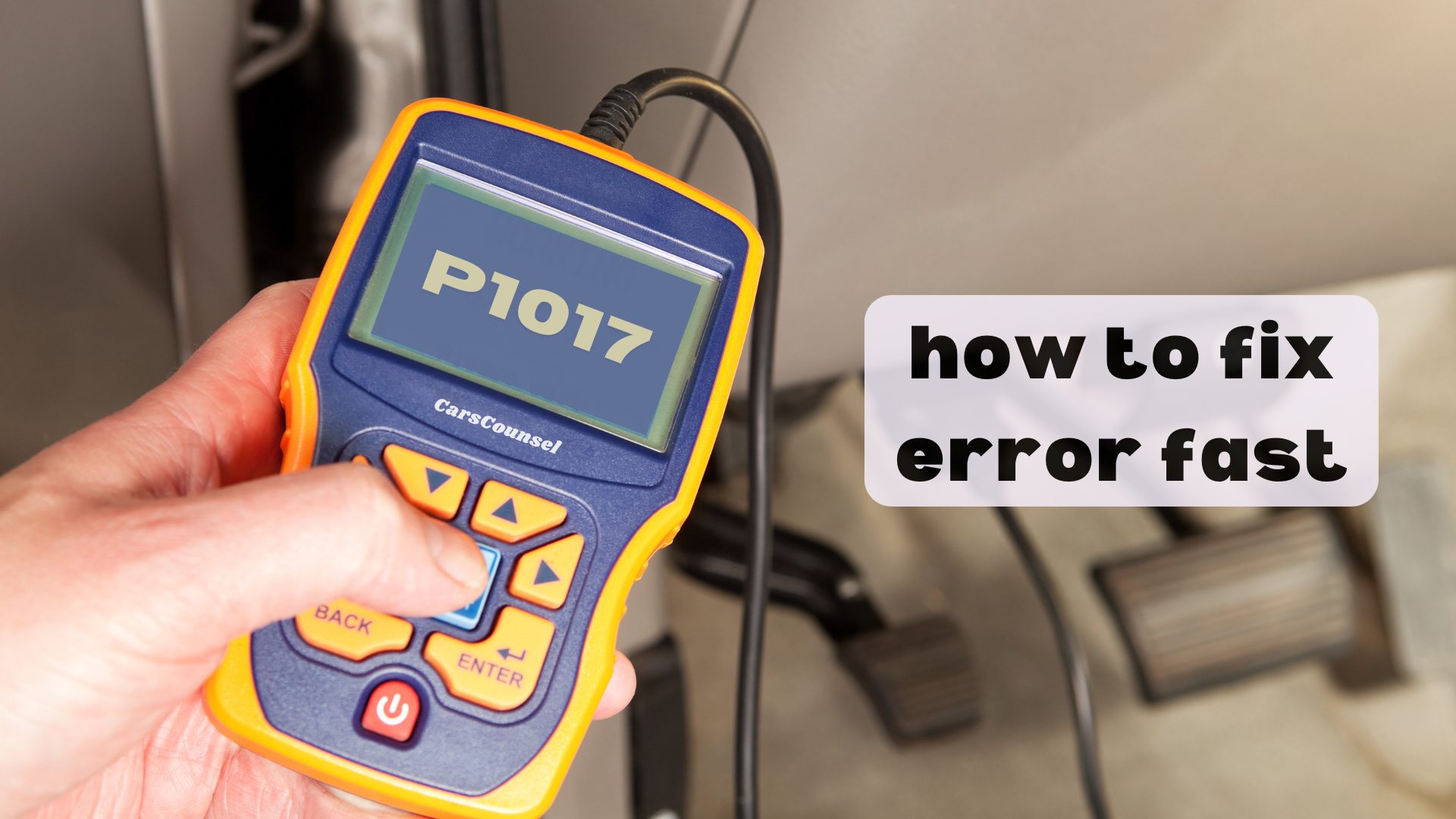Did you know that nearly 1 in 5 BMW owners will experience a check engine light issue at some point, and a significant portion of those cases can be attributed to the P1017 code? You’re likely here because your car’s onboard computer has flagged a problem with the Valvetronic eccentric shaft sensor’s plausibility. That’s a mouthful, but what does it mean for you?
Simply put, your engine’s performance and efficiency are at risk. You might be experiencing rough idling, loss of power, or decreased fuel efficiency, and you’re probably wondering what’s going on under the hood.

Quick Navigation
Key Takeaways
- The P1017 code indicates a problem with the plausibility of the Valvetronic eccentric shaft sensor, which affects engine performance and valve lift control.
- Common causes of the P1017 code include a faulty sensor, wiring issues, mechanical problems, software malfunction, and other potential issues.
- Symptoms of the P1017 code include rough idling, loss of power, decreased fuel efficiency, engine misfires, and illumination of the check engine light.
- To diagnose and fix the P1017 code, use a diagnostic scanner, perform engine diagnostics, and check the sensor’s wiring and connections for damage or corrosion.
- Replacing the faulty sensor requires purchasing a compatible replacement, disconnecting the electrical connector, and guaranteeing the new sensor functions correctly.
Understanding Code P1017
Your car’s onboard diagnostics system has flagged a pivotal issue with the Valvetronic eccentric shaft sensor, triggering the P1017 code.
This fault code indicates a problem with the sensor’s plausibility, which is imperative for the Valvetronic system’s operation. The sensor monitors the position of the Valvetronic eccentric shaft, controlling valve lift.
Valve lift issues can significantly impact engine performance, leading to reduced power, poor fuel economy, and engine misfires. The sensor’s functionality is indispensable for peak engine operation, and any malfunction can trigger the P1017 code.
Understanding the code and its relation to sensor functionality is paramount for identifying and addressing the underlying issue.
Common Causes of P1017
When the P1017 code appears, it’s essential to investigate the root cause of the issue. You’ll need to identify the underlying problem to fix it effectively. Here’s a breakdown of the common causes:
| Cause | Description |
|---|---|
| Faulty sensor | Malfunctioning Valvetronic eccentric shaft sensor |
| Wiring issues | Damage to sensor wiring or poor electrical connections |
| Mechanical issues | Problems with the Valvetronic eccentric shaft or related components |
| Software malfunction | Glitch in the engine control unit leading to erroneous sensor readings |
| Other causes | Other potential problems may also trigger the P1017 code |
Sensor failure rates are relatively high, so it’s vital to inspect the sensor and its wiring carefully. Wiring inspection tips include checking for damage, corrosion, or loose connections. By understanding the common causes, you’ll be better equipped to diagnose and fix the issue. Sensor failure rates are relatively high, so it’s pivotal to inspect the sensor and its wiring carefully.
Symptoms of the P1017 Code
Identifying the symptoms of the P1017 code is vital to understanding the impact of the faulty Valvetronic eccentric shaft sensor on your vehicle’s performance.
You may notice rough idling, which can be annoying and unsettling. The engine might idle roughly or inconsistently, making it difficult to maintain a steady speed.
Additionally, you may experience a loss of power, especially during acceleration, which can be frustrating.
Moreover, a faulty sensor can cause your engine to run inefficiently, resulting in decreased fuel efficiency.
You might also notice engine misfires or uneven engine performance.
The most essential symptom, however, is the illumination of the check engine light.
Diagnosing and Fixing P1017
How do you pinpoint the root cause of the P1017 code and rectify the issue?
To diagnose the problem, start by using a diagnostic scanner to read the fault codes and confirm the P1017 code.
Then, perform engine diagnostics to identify if the issue is related to the sensor, wiring, or mechanical components.
Check the sensor’s wiring and connections for damage or corrosion and repair or replace as needed.
If the sensor is faulty, you may need to perform sensor calibration to guarantee accurate readings.
Once you’ve identified the root cause, you can begin the repair process.
Clear the fault codes from the ECU to reset the system, and take the vehicle for a test drive to verify the issue has been resolved.
Replacing the Faulty Sensor
You’ll need to replace the faulty Valvetronic eccentric shaft sensor with a new one to resolve the P1017 code issue.
Before doing so, perform a thorough sensor inspection to identify any signs of damage or wear. This will help you determine the root cause of the problem and guarantee the new sensor functions correctly.
- Purchase a compatible replacement sensor: Make sure the new sensor is compatible with your vehicle’s make and model.
- Disconnect the electrical connector: Carefully disconnect the electrical connector from the faulty sensor to avoid damaging the wiring.
- Perform shaft maintenance: After replacing the sensor, perform routine shaft maintenance to prevent future issues.
Repairing Wiring and Connections
Three critical components of the Valvetronic eccentric shaft sensor circuit are the wiring, connections, and electrical connector, all of which must be thoroughly inspected and repaired if necessary to guarantee proper sensor function and confirm reliable operation.
You’ll need to carefully examine the wiring harnesses for signs of damage, corrosion, or wear. Check electrical connections for looseness, corrosion, or overheating, as these can cause faulty sensor readings. Make sure to repair or replace any damaged wiring or connections to verify a secure and reliable connection.
Additionally, inspect the electrical connector for corrosion or damage and clean or replace it as needed. By doing so, you’ll certify the Valvetronic eccentric shaft sensor receives the proper signals, allowing it to function correctly.
Clearing Fault Codes and Testing
Once you’ve completed the necessary repairs to the wiring and connections, it’s time to clear the fault codes from the engine control unit (ECU) and test the system to verify the P1017 code has been resolved.
To confirm the issue is fully resolved, follow these steps:
- Clear the fault codes: Use a diagnostic scanner to clear the P1017 code from the ECU’s memory.
- Sensor recalibration: If necessary, recalibrate the Valvetronic eccentric shaft sensor to guarantee accurate readings.
- Test drive analysis: Take the vehicle for a test drive to monitor the system’s performance and verify the code has been resolved.
Estimated Repair Costs and Considerations
Several factors influence the total cost to fix the P1017 code, including the cost of the replacement sensor, labor costs, and any additional repairs needed to address related issues.
You can expect to pay between $100 and $300 for a new sensor, depending on your vehicle’s make and model. Labor costs will add to the total bill, and if wiring repairs are needed, that’ll increase the cost further.
Your total repair estimate could range from $200 to $500 or more. Be sure to consult with a qualified mechanic for a more accurate quote.
Additionally, check your insurance coverage to see if it covers repairs related to the P1017 code. Having a clear understanding of the repair estimates will help you plan and budget for the necessary fixes.
More OBD-II Codes
Frequently Asked Questions
Can a Faulty Valvetronic Eccentric Shaft Sensor Cause Engine Damage?
You’re wondering if a faulty Valvetronic eccentric shaft sensor can cause engine damage. Yes, sensor failure can lead to incorrect valve lift adjustments, potentially causing engine misfires, overheating, and even catastrophic damage if left unchecked, highlighting the importance of engine protection.
Will a P1017 Code Trigger a “Limp Home Mode” on My Vehicle?
Notably, 75% of modern vehicles are equipped with limp home mode. When you encounter a P1017 code, yes, it can trigger limp mode activation, limiting engine performance to prevent further damage, and reducing your vehicle’s power and speed.
Can I Drive My Vehicle Safely With a P1017 Code?
When driving with a faulty Valvetronic sensor, you should exercise caution, limiting mileage and avoiding heavy loads. It’s generally safe to drive short distances, but prolonged use can lead to decreased performance, poor fuel efficiency, and potential engine damage.
Will a Tune-Up or Oil Change Fix a P1017 Code?
You won’t fix the P1017 code with a tune-up or oil change, as they don’t address the faulty Valvetronic eccentric shaft sensor; instead, focus on replacing the sensor, and while you’re at it, inspect spark plugs and fuel injectors to guarantee peak engine performance.
Can a P1017 Code Be Triggered by Low Fuel Pressure?
You’re wondering if a P1017 code can be triggered by low fuel pressure. Yes, it’s possible, as a faulty fuel pump or clogged fuel filter can cause low fuel pressure, leading to incorrect valve lift adjustments and sensor plausibility issues.
Conclusion
You’ve finally cracked the code – literally! The P1017 error has been diagnosed and repaired, and your engine’s Valvetronic system is humming along smoothly again. But here’s a surprising twist: research suggests that a faulty Valvetronic eccentric shaft sensor can also be caused by worn engine bearings, which can lead to premature sensor failure. So, be sure to inspect those bearings during your next major engine overhaul to prevent future issues.

